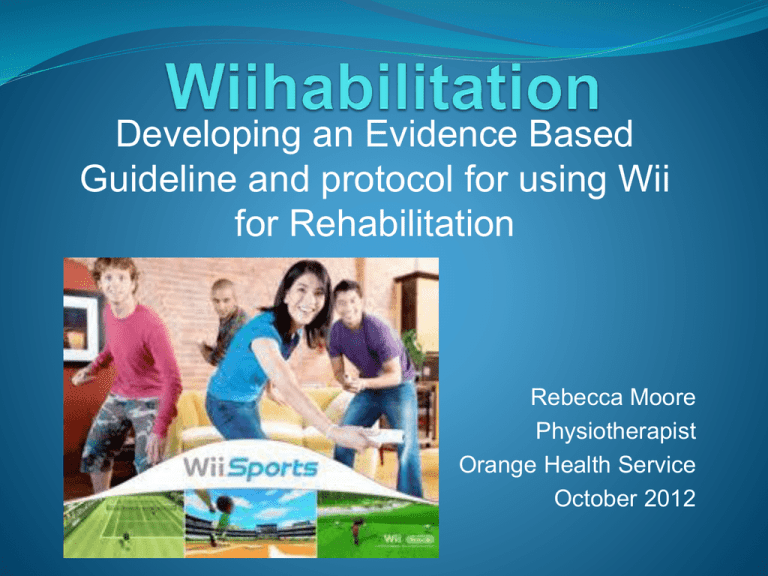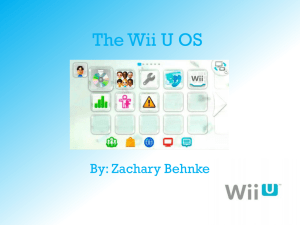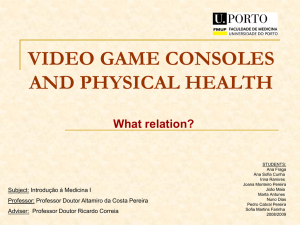7th November - Rebecca Moore
advertisement

Developing an Evidence Based Guideline and protocol for using Wii for Rehabilitation Rebecca Moore Physiotherapist Orange Health Service October 2012 Outline Overview of the Wii System Background (Issue and Aims of the project) Evidence for intervention Limitations to the evidence Protocol Development and Use Future Directions What is Wii? The Nintendo Wii was developed and released by Nintendo in 2006 as an of the shelf virtual reality gaming system. It involves interacting with a virtual environment projected on the TV screen using hand held remotes or a weight sensing balance board. Components TV screen Used to display the virtual environment Provides feedback on interaction with the environment Wii Console Holds the software disc Components Wii Remote/s Wireless, hand held, motion-sensitive controls Can be used as a direct pointing device Feedback provided by a rumble device and a built-in speaker in the remote. Wii Fit Balance Board Motion sensitive Interprets the movement of the feet and senses weight distribution over base of support What is Wiihabilitation? “Wiihabilitation” refers to the use of the Nintendo Wii virtual reality system as a form of rehabilitative therapy. The Issue Nintendo Wii was purchased for OHS Rehab Unit but it was being under-utilised. The Aim • To develop an evidence based guideline for using Wii for Rehab. • To develop a protocol for using Wii in the rehab setting. The Evidence for Wiihab Limited research presently Review of evidence revealed 5 studies appropriate to relate to our PICOT question “Can Nintendo Wii be used as a useful adjunct to physiotherapy service in a rehabilitation unit to facilitate improved patient outcomes regarding function and independence post stroke?” 1 x meta analysis – Looked at multiple Virtual Reality Technologies 3 x RCT’s one of which was included in the meta analysis Saposnik et al - Effectiveness of Virtual Reality Using Wii Gaming Technology in Stroke Rehabilitation A Pilot Randomised Control Trial and Proof of Principle (Stroke. 41(7): 1477-84, 2010 Jul.) Purpose To examine the feasibility, safety and efficacy of using Wii in patients post stroke to facilitate motor function of the upper extremity required for activities of daily living. Design Randomised, Single Blind, Parallel group trial Sample 22 participants, aged 18-85, sub acute phase (up to 6 months) Able to shrug shoulders and touch chin with affected arm. Saposnik et al - Cont. (Stroke. 41(7): 1477-84, 2010 Jul.) Results Wii group had a significant improvement in mean motor function (Wolf Motor Function Test) of 7 seconds compared to control Conclusion Wii gaming technology does represent a safe, feasible and potentially effective alternative to facilitate rehabilitation therapy and promote motor recovery after stroke. Kim et al – Use of Virtual Reality to Enhance Balance and ambulation in Chronic Stroke. A double-blind Randomised Controlled Study (Am J of Phy Med and Rehab. 88: 693-701, 2009.) Purpose To examine the additive effect of virtual reality on balance and gait function in patients with chronic hemiparetic stroke Design Double Blinded Randomised Control Study Sample 24 Adults, at least 1 year post stroke, With the ability to stand and walk indoors Kim et al – Cont. (Am J of Phy Med and Rehab. 88: 693-701, 2009.) Result Experimental group had improved BBS and significant improvements in velocity, modified MAS scores, cadence, step time, step length and stride length. Conclusion Virtual reality has an augmented effect on balance and associated locomotor recovery in adults with hemiparetic stroke when added to conventional therapy. Hurkmans et al – Energy Expenditure in Chronic Stroke Patients playing Wii Sports: a pilot study Journal of Neuroengineering and Rehab. 8:38,2011 Purpose To investigate if the intensity of physical activity and therefore energy expenditure among chronic stroke patients while playing Wii Sports is sufficient to meet current evidence based guidelines for maintenance and improvement of health among stroke survivors. Conclusion Mean energy expenditure reached appropriate levels for moderate exercise, 3.7 METs for tennis and 4.1 METs for boxing What the evidence doesn’t tell us What about the patients that don’t’ fit the inclusion criteria of the studies? Only looks at a very few select games Doesn’t indicate how to pick which games to use with which patients Requirements of a protocol A way to match the patients ability and skill level with the difficulty and skill requirements of a game A way to pick the right game to train what you want to improve Simple decision mechanism for therapists not familiar with Wii games to use Wii Developing a protocol Step 1 – Compile a database of games that included: Skills required for each game (motor and cognitive) Equipment required for each game Various ways to play the game (ie. seated, standing) Database Sample Disc Game SubGame UL/LL/WB/ Unilateral or Balance Bilateral Wii Fit Training Plus Perfect 10 Balance Equipment Required Seated or Standing MET levels Skills Required NA Balance Board Standing 2.5 -Standing Balance -Weight shift 4 directions -Simple Calculation Cycling Whole Body Bilateral Balance Board + Controller Standing 2.5 - Standing Balance - March on spot -BIlat arm steering Rhythm Kung Fu Whole Body Bilateral Balance Board + Controller + nunchuck Standing 3 - High Level balance skills - Timing Driving Range Whole body Bilateral Balance board + controller Standing 3 -Standing balance -UL bilat swing Segway Circuit Whole body Bilateral Balance Board + controller Seated or standing 2 Birds Eye Bulls Eye Whole body Bilateral Balance Board Seated or standing 2.5 -weight shift forward and back -steering with bilat upper limbs -weight shift in four directions -bilat arm abd/flapping Developing a protocol Step 2 – Choose a standardised tool to assess a patients impairments and skill level. Motor Assessment Scale 8 items Scored from 1-6 (Rolling, Bed Mobility, Sitting Balance, Sit to Stand, Walking, Upper Arm Function, Hand Movements, Advanced Hand Activities) Motor Assessment Scale Developing a protocol Step 3 – Create a system by which therapists can match the skills of the patient to the appropriate games available on Wii. Decision Trees Static Balance Lower limb function and dynamic balance Arm function Cardiovascular Fitness Where we are at now Trialling the decision trees in our rehab unit Set up as part of circuit training group at present Biggest limitation to use is cognition Getting feedback from patients and therapists Continuing to monitor emerging evidence and adapt practise to meet evidence recommendations Future Directions Research project in the clinical setting Rotating staff through the area Blinding difficult in a small setting Ethics approval Needs to be an adjunct to routine therapy .. Time constraints Applicability across settings Paediatrics Acute wards In the community The Beginning!









